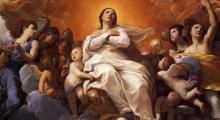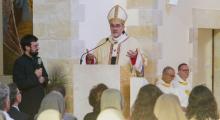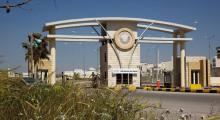Issued by the Catholic Center for Studies and Media - Jordan. Editor-in-chief Fr. Rif'at Bader - موقع أبونا abouna.org

On Thursday, August 14 and Friday, August. 15, the Solemnity of the Assumption of the Blessed Virgin Mary was celebrated in Jerusalem.
The vigil took place, on Thursday night, in the Garden of Olives adjacent to the Basilica of Agony (Gethsemane), and then continued with the celebration of the Solemn Mass, on Friday morning, presided over by the Custos of the Holy Land, Br. Francesco Ielpo.
The vigil in the night
In the garden next to the Basilica of Gethsemane, the vigil was held with a procession into the basilica. Presided over by the Custos of the Holy Land, it saw the participation of numerous local religious men and women, as well as the Franciscan friars of the Custody of the Holy Land.
The presence of many consecrated men and women was at the center of the reflection of the Custos, shared at the end of the prayer. Once inside the Basilica, Br. Ielpo scattered rose petals, soaked with the perfume of nard, on the statue representing the Virgin Mary carried in procession. That gesture, he underlined, recalled to him the value of our daily "yes": the response to the Lord's call that every priest, nun or consecrated person renews day after day.
We are all invited to offer our "yes" to Mary and to her only begotten Son like fragrant petals, a concrete sign of a desire for service that we want to preserve and rekindle every day, like a fragrance that spreads.
The celebration of the Eucharist
In his homily, Br. Ielpo invited us to turn our gaze towards Heaven, contemplating Mary as a living and concrete sign of God's presence in history. The liturgy, recalling the image of the ark of the covenant described in the Book of Revelation, the woman "clothed with the sun" and full of life, reminds us that today this ark is the Church, a community that keeps Christ in its heart and gives him to the world, even while passing through trials and difficulties. Like a pilgrim who advances despite the contrary wind, the people of God continue their journey, certain that the final victory belongs to the Lord.
The Gospel presents Mary as Mother of the Lord and model of faith, she who welcomed the Word with trust and sang the Magnificat, the hymn of one who knows that God does not forget the small and the poor. A message that, today more than ever, is precious for Christians of the Holy Land, often immersed in situations of pain and injustice, but called to keep hope alive.
Looking to Mary means recognizing that in her the promise of God has already been fulfilled and that the same destiny of communion and peace is prepared for all. It is an invitation not to be overcome by evil, but to believe that in Christ everything will be recapitulated, healed and made new.
The visit to the Tomb of the Blessed Virgin
In the afternoon, in the grotto of Gethsemane, the Second Vespers were recited. This place, known as the "Grotto of Betrayal" or "Grotto of the Apostles", is considered the oldest part of the garden of Gethsemane and is located to the right of the entrance of the Church of the Tomb of Mary.
Afterwards, the traditional procession to the Tomb of the Virgin took place, on the only day of the year when the Franciscans are allowed to make this pilgrimage. In the past, the Friars Minor had exclusive use of the Tomb, but in 1757 they were definitively removed. Today the sanctuary is cared for by the Greek Orthodox and Armenian Orthodox communities and, together with Bethlehem, the Holy Sepulchre and the site of the Ascension, is one of the four Holy Places regulated by the Status Quo. According to this rule, the Franciscans may enter only on the feast of the Assumption.
The faithful, one by one, knelt before the Tomb, paying homage to Mary, Mother of Jesus.







